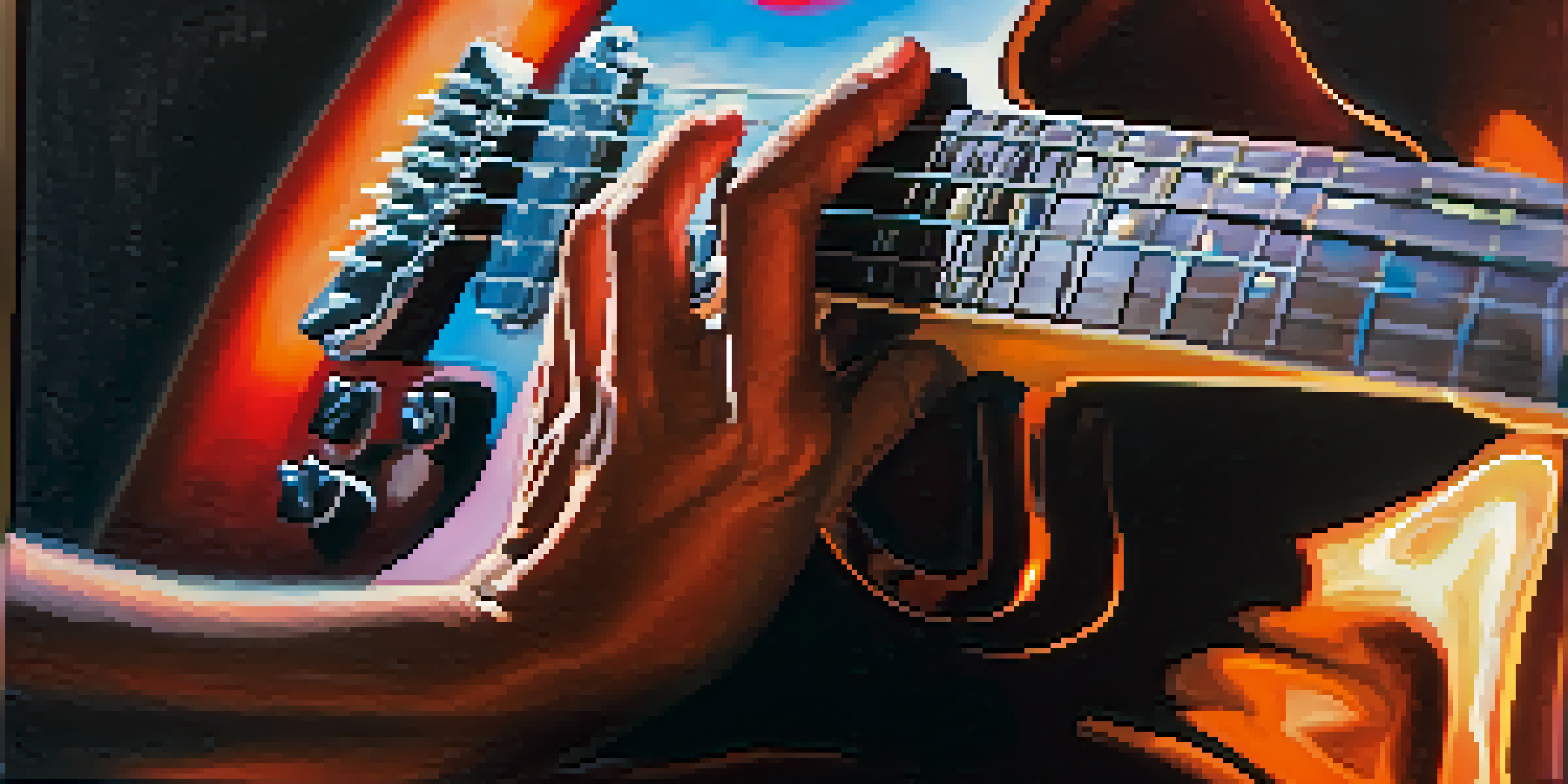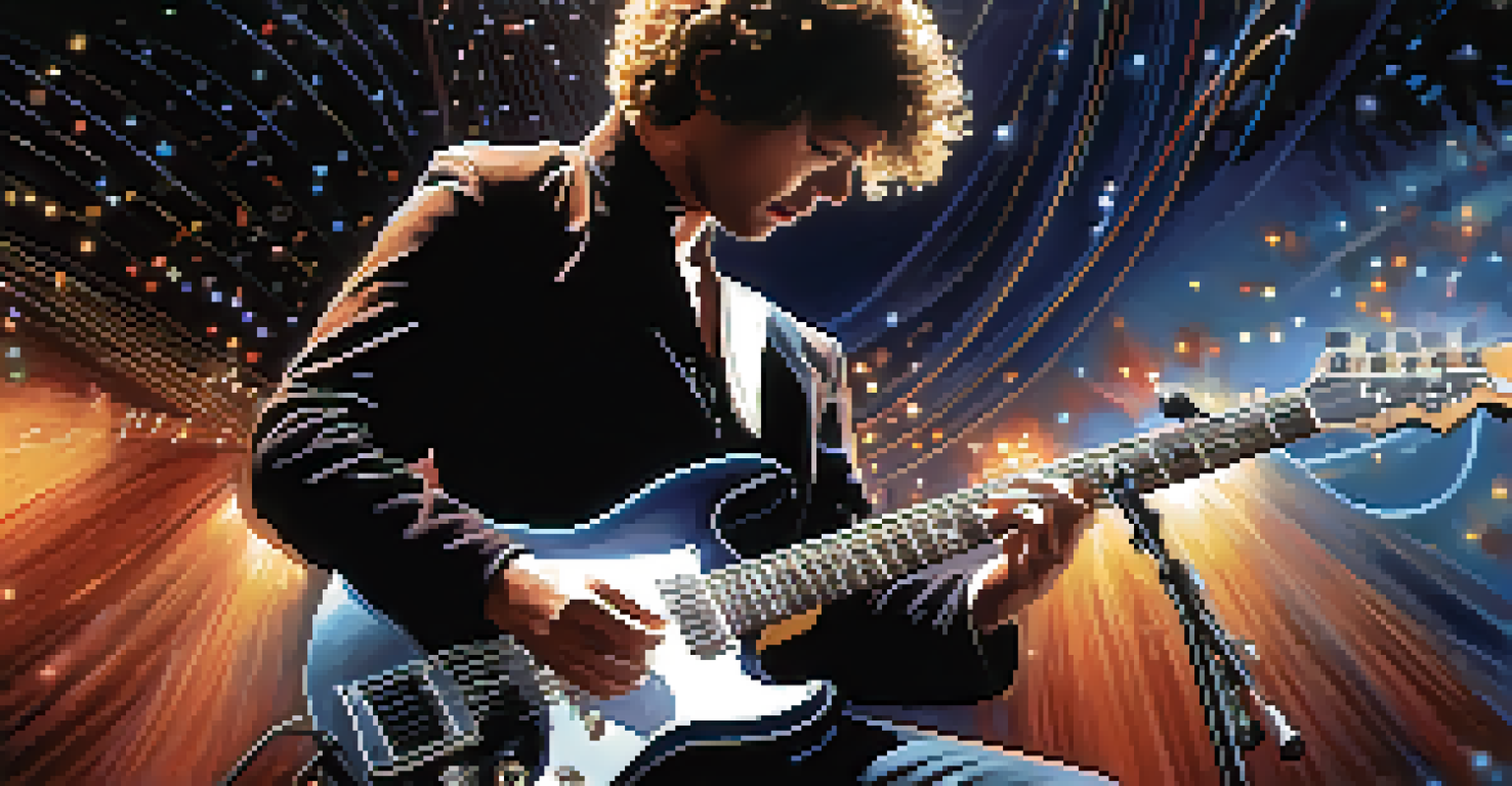Building Tension: Using Guitar Techniques to Create Emotion

Understanding Emotional Tension in Music
Emotional tension in music is much like suspense in a good story. It keeps the listener on the edge of their seat, eager to hear what comes next. Just as a well-timed plot twist can evoke gasps, so too can a guitar riff build anticipation or release it.
Music is the shorthand of emotion.
Creating tension is about using techniques that evoke feelings—whether it’s joy, sadness, or excitement. Guitarists can tap into this emotional language to connect with their audience on a deeper level. The right notes played in the right way can turn a simple melody into a powerful experience.
For instance, think about how a minor key can evoke a sense of melancholy. By understanding these emotional triggers, guitarists can craft songs that resonate, making audiences feel every note.
Using Dynamics to Create Tension
Dynamics in music refer to the volume of notes and how they change throughout a piece. By varying the dynamics, guitarists can create a sense of build-up and release, much like a roller coaster ride. Soft notes can draw listeners in, while sudden, loud bursts can jolt them awake.

Imagine playing a gentle arpeggio that slowly crescendos into a powerful chord. This dynamic shift not only creates excitement but also pulls the audience’s emotions along for the ride. It's all about pacing; knowing when to hold back and when to unleash.
Emotional Tension Engages Listeners
Emotional tension in music captivates audiences, much like suspense in a story, by using various techniques to evoke strong feelings.
By mastering dynamics, guitarists can manipulate the emotional landscape of their music, ensuring that their audience feels every rise and fall.
The Power of Harmonics in Emotion
Harmonics are a beautiful tool in a guitarist's arsenal, often creating ethereal sounds that evoke a sense of wonder. When used effectively, harmonics can add depth and complexity to a piece, making it more emotionally charged. Think of them as the icing on the cake, enhancing the overall flavor of the music.
The beautiful thing about music is that it connects people. It carries a message, and we, the musicians, are the messengers.
For example, a simple melody can transform into something magical with the addition of harmonics, pulling listeners into a dreamlike state. This technique can be particularly effective during climactic moments in a song, amplifying the emotional impact.
By incorporating harmonics, guitarists can explore new textures and feelings, allowing them to convey a broader spectrum of emotions.
Bending Notes for Expressive Tension
Bending notes is a classic technique that infuses guitar playing with emotion. By slightly altering the pitch of a note, guitarists can express feelings that straight notes simply can't convey. It's like adding a sigh or a laugh to a conversation—small, but impactful.
This technique is especially effective in blues and rock genres, where expressing raw emotion is key. A well-timed bend can evoke longing, pain, or even joy, creating a powerful connection between the musician and the audience.
Dynamics Shape Emotional Experience
Varying dynamics in music creates a roller coaster of emotions, allowing guitarists to guide listeners through moments of build-up and release.
Ultimately, bending notes allows guitarists to tell a story, giving life to their music and making it relatable on a personal level.
The Role of Rhythm in Building Tension
Rhythm plays a crucial role in creating emotional tension, as it dictates the pace of a piece. By experimenting with different rhythmic patterns, guitarists can evoke various emotions—fast rhythms can induce excitement, while slower rhythms can create a sense of sadness or reflection.
Consider a song that alternates between quick, energetic strumming and slow, deliberate picking. This contrast not only keeps listeners engaged but also heightens emotional impact. The unpredictability of rhythm can mirror life's own ups and downs.
By harnessing the power of rhythm, guitarists can craft compelling narratives that resonate deeply with their audience.
Exploring Scales for Emotional Depth
Different musical scales have unique emotional qualities, which guitarists can leverage to create tension. For example, the pentatonic scale often evokes a sense of longing, while the diminished scale can create feelings of unease. Understanding these nuances is essential for any guitarist looking to enhance their emotional expression.
By selecting the right scale for a specific mood, guitarists can guide their audience through a wide range of emotions. A simple shift from a major to a minor scale can dramatically change the feel of a piece, illustrating how powerful scales can be.
Combining Techniques Enhances Emotion
The most powerful emotional impact occurs when guitarists blend various techniques, creating a rich and captivating musical narrative.
Ultimately, the choice of scale can be a pivotal factor in a song's emotional journey, allowing guitarists to paint vivid sonic landscapes.
Combining Techniques for Maximum Impact
The true magic happens when guitarists combine various techniques to create a rich tapestry of emotion. For instance, using harmonics alongside dynamic shifts can elevate a simple melody into something extraordinary. It's like mixing colors on a canvas—each technique adds depth and dimension.
Moreover, the interplay between rhythm and bending notes can evoke raw emotion that resonates deeply with listeners. By weaving together these different elements, guitarists can craft a unique sound that stands out.

Ultimately, it's about experimentation and finding the right balance. The more techniques a guitarist masters, the more powerful their emotional storytelling becomes.